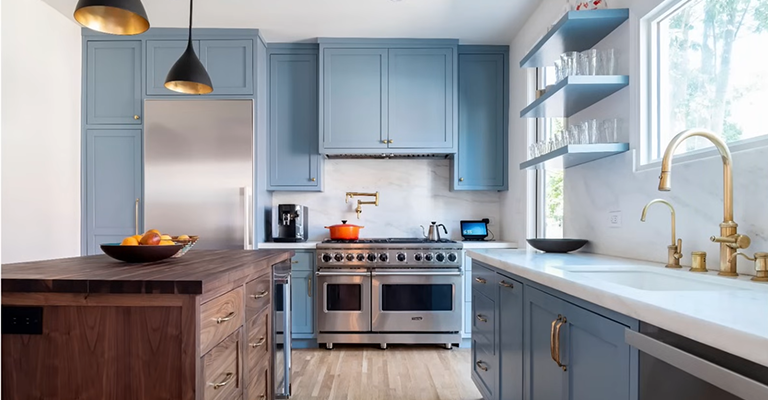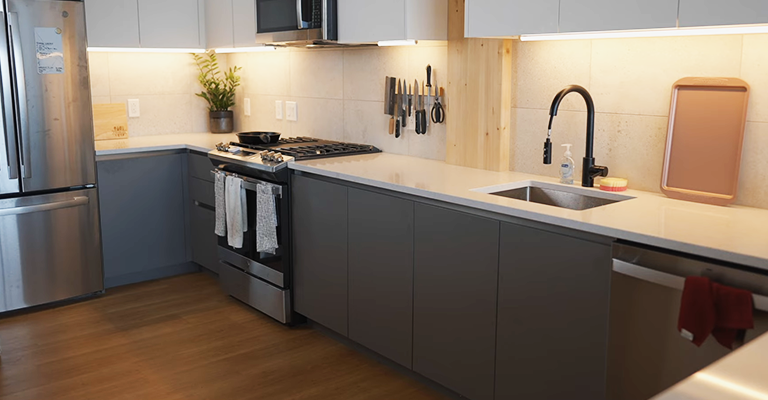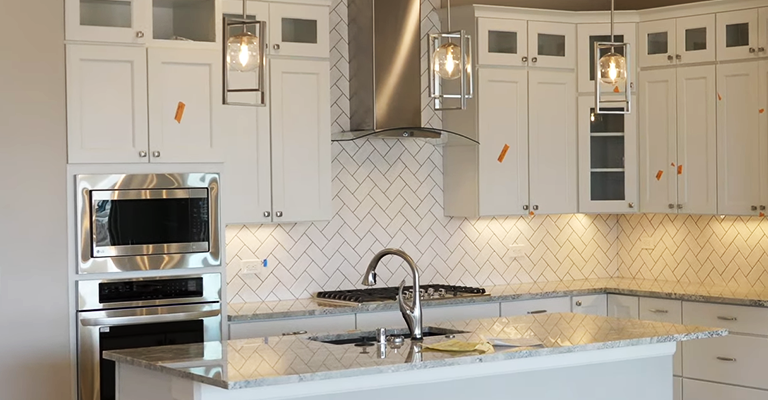Why Washing Machine In Kitchen?-Exploring Practical Reasons
The placement of a washing machine within a household is a decision that bears significant practical implications.
Among the various options, situating this indispensable appliance in the kitchen stands as a common and highly functional choice. This arrangement is rooted in a confluence of factors, ranging from plumbing accessibility to space efficiency.
The kitchen, often regarded as the heart of a home, provides ready access to water sources and drainage facilities, streamlining the installation process.
Furthermore, this configuration aligns with modern lifestyles, where multitasking and convenience reign paramount.
This introduction delves into the compelling reasons why the kitchen serves as an optimal locale for the washing machine, addressing both utility and contemporary living needs.

Why Washing Machine In the Kitchen?
Having a washing machine in the kitchen is a common arrangement in many households, and it serves a variety of practical purposes.
Here are several reasons why this setup is preferred by homeowners:
Plumbing Accessibility
The kitchen is often centrally located in a home, making it a natural hub for plumbing connections. Water supply lines and drainage systems are readily available, reducing the need for extensive and costly plumbing work elsewhere in the house.
This setup also makes it easier to address any maintenance or repair issues related to the washing machine’s plumbing.
Space Efficiency
Kitchens are usually one of the larger areas in a home. Integrating the washing machine here allows for efficient utilization of space without the need for additional rooms or special compartments.
It also avoids the need to allocate precious square footage to a separate laundry room, which may not always be feasible in smaller or more compact living spaces.
Proximity to Water Sources
Kitchens are designed with easy access to both hot and cold water supplies. This ensures that the washing machine can be connected to a reliable and adequate water source, facilitating efficient and effective laundry cycles.
It also minimizes the risk of water supply issues that may arise from connecting the washing machine to more distant water sources.
Drainage Facilities
Kitchens are equipped with robust drainage systems designed to handle the flow of water from sinks, dishwashers, and other appliances.
This existing infrastructure can be effortlessly extended to accommodate the washing machine’s drainage needs.
This simplifies the installation process and ensures efficient water disposal during each laundry cycle.
Ventilation and Drying Options
Kitchens are often equipped with ventilation options, such as windows, extractor fans, or range hoods. This aids in dispersing moisture and humidity generated during the laundry process, helping to maintain a comfortable indoor environment.
Additionally, kitchens can be further equipped with specialized drying racks or areas, enhancing the overall efficiency of the laundry process.
Convenience and Accessibility
The kitchen’s central location within a home makes it a highly accessible area for daily chores. Placing the washing machine here ensures that it’s within easy reach for everyone in the household, streamlining the laundry routine.
This proximity reduces the time and effort required to transport laundry to and from a separate laundry room or distant location.
Multi-Purpose Area
Modern kitchens are designed to be versatile spaces, accommodating various activities beyond cooking. They serve as hubs for dining, socializing, and even working or studying.
Integrating the washing machine allows for seamless multitasking, enabling household members to manage chores while engaging in other activities.
Design Aesthetics
Modern appliances, including washing machines, are increasingly designed with aesthetics in mind. Integrating them into the kitchen’s overall design and layout creates a cohesive and visually pleasing environment.
Matching or complementing the washing machine’s design with the kitchen’s decor can contribute to a harmonious and unified look throughout the living space.
Traditional Laundry Areas vs. Modern Trends

The way we approach laundry spaces in our homes has evolved significantly over the years.
Traditional laundry areas and modern trends in laundry room design offer distinct approaches to the task of cleaning and maintaining our clothing and household linens.
Let’s explore the key differences between these two perspectives.
Traditional Laundry Areas
Dedicated Rooms
In the past, laundry rooms were standalone spaces, typically tucked in basements or utility areas.
They were functional but often lacked the aesthetic considerations seen in other parts of the home.
Isolation from Living Spaces:
Traditional laundry areas were deliberately placed away from the main living areas to contain noise, moisture, and the visual clutter associated with laundry activities.
This separation was a practical consideration, but it could also lead to a somewhat disconnected household flow.
Emphasis on Utility:
Functionality was paramount in traditional laundry areas.
They were equipped with basic fixtures for washing, drying, and ironing clothes. Aesthetics were often secondary to the practicality of the space.
Limited Design Considerations:
Décor and design in traditional laundry areas were often minimal. These spaces were primarily utilitarian, with an emphasis on easy-to-clean surfaces and durable materials.
Modern Trends
Integration into Living Spaces:
Contemporary design trends emphasize the integration of laundry facilities into high-traffic areas like kitchens or bathrooms.
This shift reflects a desire for greater convenience and a more seamless household flow.
Multi-Functional Spaces:
Modern homes are increasingly designed with multifunctionality in mind.
Combining the laundry area with other spaces allows for efficient use of square footage, supporting activities beyond just laundry.
Aesthetic Considerations:
Today’s laundry areas are given the same design attention as other parts of the home.
Stylish cabinetry, decorative tiles, and ergonomic layouts are becoming the norm, creating spaces that are both functional and visually appealing.
Technological Integration:
The integration of technology is a hallmark of modern laundry areas.
High-efficiency appliances, smart controls, and energy-saving features are now standard, reflecting a commitment to sustainability and convenience.
Accessibility and Convenience:
Placing laundry facilities in high-traffic areas like the kitchen or bathroom reduces the effort required for routine chores.
This placement acknowledges the fast-paced nature of modern life and the need for streamlined processes.
Flexibility in Design
Modern trends allow for greater flexibility in choosing the location of laundry facilities.
Whether integrated into a kitchen, bathroom, or dedicated laundry room, homeowners have more options to suit their specific needs and preferences.
Which Is It Better to Have a Washing Machine in the Kitchen or Bathroom?
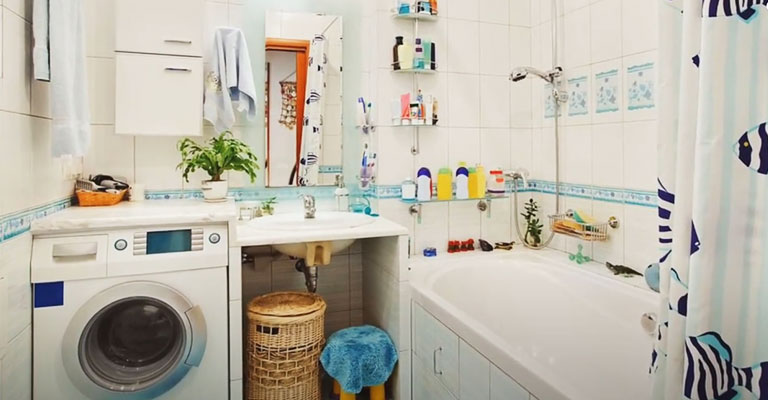
The decision of whether to place a washing machine in the kitchen or bathroom depends on individual preferences, available space, and practical considerations. Both locations have their own advantages and potential drawbacks.
Here are some factors to consider:
Placing a Washing Machine in the Kitchen:
Advantages
- Convenience of Plumbing: Kitchens are typically equipped with water supply lines making it easy to connect a washing machine.
- Proximity to Water Sources: Kitchens have easy access to both hot and cold water supplies, which is crucial for the efficient operation of a washing machine.
- Ventilation: Kitchens are usually well-ventilated spaces, which helps disperse moisture and humidity generated during the laundry process.
Considerations
- Space Constraints: When the kitchen is small, adding a washing machine might reduce available counter and storage space.
- Aesthetic Preferences: Some people may not prefer the visual presence of a washing machine in their kitchen.
Placing a Washing Machine in the Bathroom:
Advantages
- Existing Plumbing: Bathrooms are already equipped with plumbing for water supply and drainage, making it relatively straightforward to install a washing machine.
- Concealed Location: The washing machine can be discreetly placed in a bathroom cabinet, keeping it out of sight when not in use.
- Convenience: Placing a washing machine in the bathroom provides easy access to a water source and drainage.
Considerations
- Limited Space: Bathrooms are typically smaller than kitchens, so space might be more limited for a washing machine.
- Aesthetics and Design: Some people may find the presence of a washing machine in the bathroom less aesthetically pleasing or less harmonious.
- Ventilation: Bathrooms may have limited ventilation compared to kitchens, which could be a consideration for moisture and humidity control.
Where Is the Appropriate Place to Place a Washing Machine?
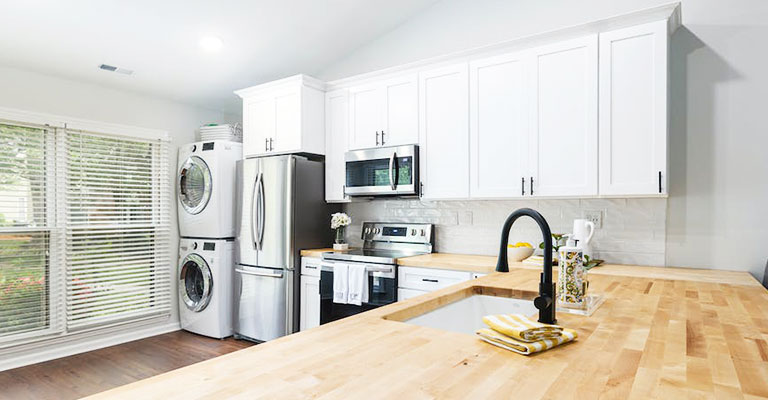
The appropriate place to install a washing machine depends on various factors including available space, plumbing, and personal preferences.
Here are some common options and considerations for placing a washing machine:
Dedicated Laundry Room
- Advantages: A dedicated laundry room provides ample space for the washing machine, along with storage for laundry supplies. It also allows for the installation of additional appliances like dryers and laundry sinks.
- Considerations: This option may not be available in all homes due to space constraints.
Kitchen
- Advantages: Many homes have washing machines in the kitchen, especially in smaller or more compact living spaces. This location provides easy access to plumbing and drainage facilities.
- Considerations: The noise and visual presence of the washing machine in the kitchen may not be preferred by everyone. Additionally, it may occupy valuable kitchen space.
Bathroom
- Advantages: Placing a washing machine in the bathroom can be convenient as it already has plumbing in place. It also allows for easy access to a water source and drainage.
- Considerations: This option may work well for smaller homes or apartments, but it could make the bathroom feel cramped. Adequate ventilation and moisture management are also important considerations.
Closet or Niche
- Advantages: Installing a washing machine in a closet or niche can help save space, especially in apartments or homes with limited square footage. It keeps the laundry area discreetly tucked away.
- Considerations: Adequate ventilation, plumbing, and electrical provisions need to be considered. Additionally, this option may not be feasible in all homes due to space constraints.
Garage or Utility Room
- Advantages: A garage or utility room provides ample space for a washing machine, along with the potential for additional storage and utility sinks. It’s also a suitable location for more robust laundry tasks.
- Considerations: In colder climates, garages may not be insulated as well as other areas of the home, which could affect the efficiency of the washing machine. Proper drainage and ventilation are important considerations.
Mudroom or Entryway
- Advantages: Placing a washing machine in the mudroom or entryway can be convenient for families with active lifestyles. It allows for quick clean-up of dirty or muddy clothes before they enter the main living spaces.
- Considerations: Adequate space, plumbing, and ventilation are crucial. Additionally, some households may prefer to keep the mudroom solely for its intended purpose.
Balcony or Outdoor Area
- Advantages: For homes with limited indoor space, placing a washing machine on a covered balcony or in an outdoor utility area can be a viable option. This can help free up interior space.
- Considerations: The washing machine and related plumbing will need to be protected from the elements. Additionally, local climate and weather conditions should be taken into account.
Guidelines for Maintenance and Ensuring Safety
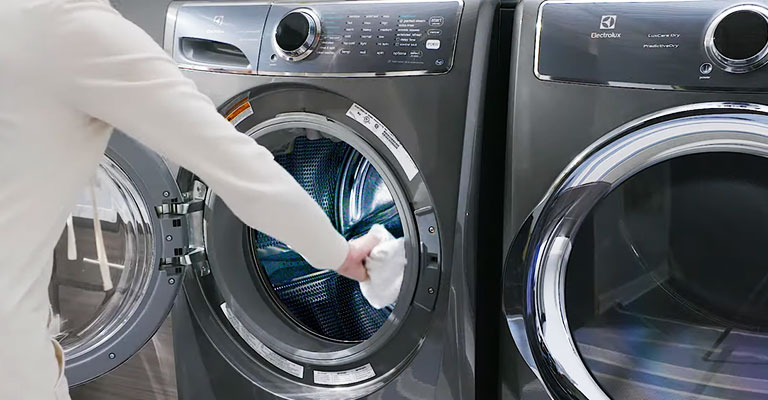
Maintaining a washing machine and ensuring its safe operation are essential for prolonging its lifespan and preventing potential hazards.
Here are some maintenance and safety tips to help you keep your washing machine in good working condition:
Read the User Manual
Familiarize yourself with the user manual that comes with your washing machine. It contains important information on operation, maintenance, and safety instructions specific to your model.
Regular Cleaning
Wipe down the exterior of the machine to prevent dust and dirt buildup. Clean the detergent and fabric softener dispensers regularly to prevent clogs and mold growth. Run an empty hot water cycle with vinegar or a washing machine cleaner to remove residue and odors.
Inspect Hoses and Connections
Periodically check the inlet hoses for signs of wear, such as cracks or leaks. Replace them if necessary. Ensure that the hoses are properly connected and not kinked to maintain a consistent water supply.
Clean the Lint Filter
Many washing machines have a lint filter. Clean it regularly to prevent clogs that can affect the machine’s drainage and performance.
Level the Machine
Ensure that the washing machine is level and stable. Use a leveling tool if necessary to prevent excessive vibration during operation.
Use the Right Detergent
Use detergent and additives recommended by the manufacturer. Using excessive detergent can lead to oversudsing and machine damage.
FAQs
Why is the washing machine commonly placed in the kitchen?
The kitchen is often equipped with plumbing connections, providing easy access to water supply and drainage.
Can a washing machine be placed in a different room?
Yes, it’s possible to install a washing machine in other rooms like a dedicated laundry room, bathroom, or utility area.
Are there any plumbing considerations for placing a washing machine in the kitchen?
It’s important to ensure that there are appropriate water supply lines and drainage facilities in the kitchen.
Does placing a washing machine in the kitchen affect the kitchen’s aesthetics?
It can impact the visual appearance of the kitchen, as the washing machine is a sizable appliance.
Are there any noise concerns with placing a washing machine in the kitchen?
Washing machines can generate some noise during operation. Placing it in the kitchen may be preferred over bedrooms or living rooms to minimize disturbance during laundry cycles.
To Recap
Placing a washing machine in the kitchen is a pragmatic choice for many households. Its proximity to plumbing facilities ensures easy access to water supply and drainage, simplifying installation and reducing costs.
Additionally, modern design solutions allow for seamless integration, preserving the aesthetics of the kitchen. The convenience of having the washing machine nearby streamlines daily chores, making laundry a more efficient task.
While there may be concerns about space utilization and potential noise, the overall benefits outweigh these considerations.
Ultimately, the decision to place a washing machine in the kitchen is a practical one, catering to the demands of modern living and enhancing the functionality of this central household space.


